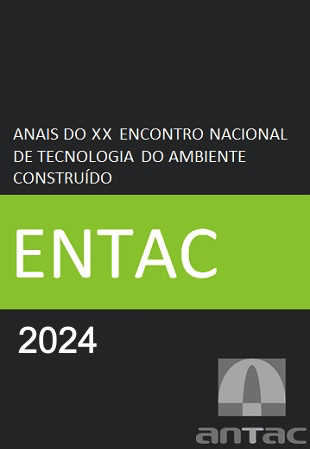Evaluation of the reactivity of glass powder waste by the ASTM C1897-20 methodology
DOI:
https://doi.org/10.46421/entac.v20i1.6346Keywords:
Pozzolanic Reactivity, Glass Waste, Isothermal Calorimetry, ThermogravimetryAbstract
The use of supplementary cementitious materials (SCMs) presents significant potential in the cement industry, as there are environmental benefits from utilizing waste from other industries and reducing CO2 emissions from cement production. Thus, the objective of this study was to evaluate the reactivity of finely ground glass through physical and chemical characterization, as well as to apply the methodology presented by the ASTM C1897-20 standard. The results highlighted the high specific surface area and fineness of the material, which contribute to its chemical activity, confirmed by the presence of the amorphous halo in the mineralogical analysis, characteristic of the vitreous state. The isothermal calorimetry test revealed a heat release of 185.49 J/g during the hydration of the paste with glass, indicating pozzolanic activity comparable to the behavior of fly ash, with the consumption of calcium hydroxide identified by thermogravimetric analysis.
References
SNIC, Relatório Anual - Sindicato Nacional da Indústria do Cimento. Brasil, 2019.
ASSOCIAÇÃO BRASILEIRA DE NORMAS TÉCNICAS. NBR 12653: Materiais pozolânicos - Requisitos. Rio de Janeiro. 2014
SILVA, M. G. Cimento Portland com adições minerais. In: Materiais de construção civil e princípios de ciência e engenharia de materiais. 2a ed. São Paulo: IBRACON, 2010. p. 791–823.
MEHTA, P. K.; MONTEIRO, P. J. M. Concreto Microestrutura, Propriedades e Materiais. 2. ed. São Paulo: IBRACON, 2014.
DAL MOLIN, D. C. C. Adições Minerais para Concreto Estrutural. In: Concreto: Ensino, Pesquisa e Realizações. 1. ed. São Paulo: IBRACON, 2005. p. 345–379.
HOPPE FILHO, J. et al. Atividade pozolânica de adições minerais para cimento Portland (Parte I): Índice de atividade pozolânica (IAP) com cal, difração de raios-x (DRX), termogravimetria (TG/DTG) e Chapelle modificado. Revista Matéria, v. 22, n. 3, 2017.
AMERICAN SOCIETY FOR TESTING AND MATERIALS. ASTM C1897-20: Standard Test Methods for Measuring the Reactivity of Supplementary Cementitious Materials by Isothermal Calorimetry and Bound Water Measurements Philadelphia, 2020.
MATOS, A. M.; SOUSA-COUTINHO, J. Durability of mortar using waste glass powder as cement replacement. Construction and Building Materials, v. 36, p. 205–215, 2012.
DU, H.; TAN, K. H. Properties of high volume glass powder concrete. Cement and Concrete Composites, v. 75, p. 22–29, 2017.
NWAUBANI, S. O.; POUTOS, IK. I. The Influence of Waste Glass Powder Fineness on the Properties of Cement Mortars. International Journal of Application or Innovation in Engineering & Management (IJAIEM), v. 2, n. 2, p. 110–116, 2013.
KHMIRI, A.; CHAABOUNI, M.; SAMET, B. Chemical behaviour of ground waste glass when used as partial cement replacement in mortars. Construction and Building Materials, v. 44, p. 74–80, 2013.
SIAD, H. et al. Mechanical, Physical, and Self-Healing Behaviors of Engineered Cementitious Composites with Glass Powder. Journal of Materials in Civil Engineering, v. 29, n. 6, p. 04017016, 2017.
ZANOTTO, E. D.; MAURO, J. C. The glassy state of matter: Its definition and ultimate fate. Journal of Non-Crystalline Solids, v. 471, n. May, p. 490–495, 2017.
VARSHNEYA, A. K.; MAURO, J. C. Fundamentals of Inorganic Glasses. 3. ed. Elsevier, 2019.
VIEITEZ, E. R. et al. End-of-Waste Criteria for Glass Cullet: Technical Proposals. Sevilla: The European Commission's science and knowledge service. EUR - Scientific and Technical Research Reports; Dez. 2011. No.: JRC68281. ISSN 1831-9424.
ASSOCIAÇÃO BRASILEIRA DE NORMAS TÉCNICAS. NBR 16697: Cimento Portland - Requisitos. Rio de Janeiro. 2018
SURANENI, P.; WEISS, J. Examining the pozzolanicity of supplementary cementitious materials using isothermal calorimetry and thermogravimetric analysis. Cement and Concrete Composites, v. 83, p. 273–278, 2017.
KIM, T.; OLEK, J. Effects of sample preparation and interpretation of thermogravimetric curves on calcium hydroxide in hydrated pastes and mortars. Transportation Research Record, n. 2290, p. 10–18, 2012.

